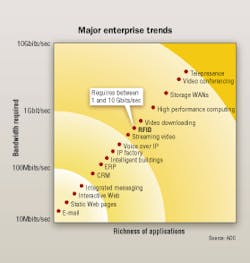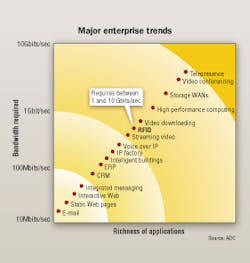How emerging network architectures can accommodate the flood of data.
During the next few years, radio frequency identification (RFID) technology is expected to have a profound impact on enterprise end user infrastructures. From retail to transportation to manufacturing to government, RFID is increasingly becoming a part of the enterprise end user’s landscape.
Today, there are emerging network infrastructures for handling RFID data and RFID endpoint powering. Enterprises that embrace RFID and prepare their infrastructures for the demands of these transformative technologies will be well positioned to take advantage of its benefits. Emerging network architectures like Gigabit Ethernet, 10-Gbit Ethernet and Power over Ethernet (PoE) are providing enterprises with the infrastructure solutions to effectively handle the impending demands of successful RFID implementations.
In a recent study released by the Aberdeen Group (www.aberdeen.com), the firm interviewed senior managers at nearly 250 companies from around the world, of whom 60 percent said RFID has great potential for their companies. Meanwhile, the independent analyst firm IDTechEx (www.idtechex.com) has projected that the worldwide RFID market will skyrocket to $26.2 billion by 2016, from the anticipated $2.7 billion in revenues that are expected to be generated this year.
In the U.S., RFID adoption has been spearheaded by Wal-Mart (www.walmart.com) and the U.S. Department of Defense (www.defenselink.mil), which have both required suppliers to use the technology. This past fall, AT&T (www.att.com) announced plans for what is believed to be the first managed RFID service by a telecom provider.
Needless to say, RFID is making tremendous headway in several industries, but none more dramatically than retail. Wal-Mart has become the leading advocate for RFID, with deployments at 500 stores in 2005, and plans to double that amount by the end of this year. As the world’s largest retailer, Wal-Mart has required suppliers to start tagging pallets and cartons to help track inventory.
RFID has the potential to provide a wide variety of benefits across several industries. It is designed to save time, reduce handling and labor costs, cut cycle times, eliminate errors and waste, and improve overall quality. But there are also major obstacles to overcome. One of the biggest hurdles is building an enterprise infrastructure that can handle the data from a plethora of RFID readers and tags.
Much attention has been focused on the readers and tags, but very little discussion has been given to how enterprise end user infrastructures will handle all the data generated by these devices. Fundamentally, RFID requires stationary, nomadic and mobile devices. Network managers will need to install new wireless and structured cabling networks to deal with all the new RFID sensors, readers and data aggregation nodes. Companies need to develop strategies that will support integration of an increasing volume of RFID data into their enterprise infrastructure, because ultimately, RFID will give enterprise end users one of their biggest data-handling challenges yet.
Flood of data
It might surprise you to learn that RFID technology has been around for 20 years. There are two types of RFID tags: active and passive.
• Active tags have electronics that communicate with the RFID reader.
• Passive tags essentially reflect the energy from the RFID reader.
Basically, an RFID reader sends a radio signal to an RFID tag, which contains a microchip and identifies an item by transmitting data to the reader. It’s helpful to think of RFID tags as “radio barcodes,” although RFID tags generate a lot more data because RFID readers, which are similar to barcode scanners, can simultaneously receive data from multiple tags. Barcode scanners, by comparison, can only process a single item at a time.
RFID tags provide a wealth of data-product information, serial numbers, shipment dates, etc. In the case of Wal-Mart, for example, the tags keep track of millions of shipments and billions of individual products sold. It has been estimated that if Wal-Mart collected information every day from every tagged item in all of its U.S. retail stores, it would generate as much as 7.7 million terabytes of data.
Given this context, it’s easy to see how enterprises deploying RFID systems could be overwhelmed by a flood of data from RFID readers. In a large-scale RFID deployment, there could be thousands of RFID readers throughout the enterprise, and the sheer number of these devices could lead to data overload.
RFID readers can swamp a network with real-time, streaming data related to the location and contents of pallets and cases. The question is: Does the enterprise end user have enough bandwidth to handle all of the RFID readers?
Bob Delaney, director of industry solutions for Sun Microsystems (www.sun.com), says that at the pallet and case level, RFID tracking is projected to cause data traffic to increase by as much as tenfold. Although Ethernet is the network of choice for wiring enterprises around the world, the rapid growth in Internet Protocol (IP) traffic and the convergence of voice, video and data applications continue to drive the demand for greater network bandwidth. For the kinds of data traffic that RFID will bring to many enterprises, Gigabit Ethernet is the answer.
With Gigabit Ethernet networks, enterprises are able to converge voice and data using Voice over IP (VoIP) and can use high-quality copper wire at distances of less than 100 meters and optical-fiber cabling for greater distances. Nevertheless, Gigabit Ethernet is by no means an RFID bandwidth panacea.
Complicating matters for Gigabit Ethernet is the fact that tracking individual items rather than just shipping pallets could mean massive growth in the number of required RFID readers and the resulting data that they would generate. Certainly, there are some industries in which we can expect to see RFID tracking go from the pallet and case level down to the item level for certain products that warrant such detailed tracking. If that’s the case, then Gigabit Ethernet networks for those particular industries might not be a viable bandwidth solution to handle all that RFID data traffic.
In those cases where the Gigabit Ethernet capacity is not enough, the next option is to go to 10-Gbit Ethernet, which is used largely by researchers at universities, financial institutions and large corporations to help build super computers and high-end data centers. The most widely used medium for implementing 10-Gbit Ethernet is optical fiber.
Either multimode or singlemode fiber is appropriate, depending on the application and distance between switches and routers. Prices for 10-Gbit Ethernet port cards have been falling, making this networking technology more attractive to corporate users and small- and mid-sized businesses. In fact, 10-Gbit Ethernet is no longer just for data centers. It’s also for critical networks that need carrier-class infrastructure.
10-Gbit Ethernet is also being carried 100 meters over UTP copper based on the emerging IEEE 802.3an standard, also known as Augmented Category 6. It will become the de facto method for Gigabit and multi-Gigabit Ethernet enterprise end user infrastructure. All Ethernet switching and routing vendors will be introducing port cards to support 10-Gbit Ethernet over UTP, which means network managers will have flexibility in mixing 10-Gbit Ethernet copper and fiber connectivity depending on the need.
Powering RFID over Ethernet
As enterprise networks encompass a wider range of IP devices, such as RFID readers, VoIP phones, security cameras and building sensors, delivering power to these devices can become a problem. This is particularly true for RFID readers that often need to be located on ceilings or other locations where there are no AC power outlets.
PoE is a cost-effective way around this problem. The technology allows RFID readers to be strategically situated in locations throughout the enterprise, including ceilings, that optimize effectiveness. Approval of the IEEE 802.3af PoE standard in June 2003 removed a significant barrier to the widespread adoption of not only IP telephony and WiFi networks but also devices like RFID readers. This IEEE standard allows electric power to be sent along the same cables that carry Ethernet data.
Before PoE, these devices required separate power cabling, conduit and AC outlets-an extremely expensive proposition for deployment. PoE solves the problem by eliminating the need for AC outlet installation, cutting maintenance and support costs, and decreasing the cost of running power to the RFID readers.
PoE-enabled switches and controllers can now deliver power over standard Category 5e or 6 Ethernet cabling to remote PoE-enabled devices like RFID readers. PoE simplifies the deployment of literally any RFID reader, particularly in areas where it may be difficult or expensive to run separate power cabling.
Companies that have invested billions of dollars in existing IP architecture that does not directly support PoE face a basic decision when deploying PoE: Should they rip out their existing Ethernet switches and replace them with PoE-compliant switches, or keep their investment in their existing infrastructure and add midspan PoE controllers that sit between an existing Ethernet switch and RFID readers, delivering both power and Ethernet data to these devices?
The bottom line is that it can be much more cost effective to use midspan PoE controllers than to buy new PoE-enabled switches.
Investment in midspan PoE controllers for RFID readers yields immediate savings in purchase and installation costs, as well as permanent and ongoing benefits due to lower support and maintenance costs, and reduced power consumption.STEVE GRADY is vice president of global marketing for ADC (www.adc.com).

